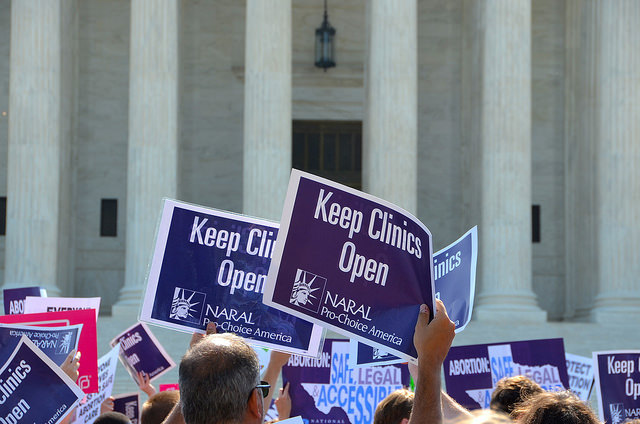From Buck v. Bell to Roe v. Wade: A Legacy of Control

Even before Roe v. Wade was overturned, reproductive choice in the United States was reserved for those with the appropriate social and financial resources. Black, Indigenous, and Latinx women were already (and will continue to be) disproportionately targeted by policies that reduce health care access, and the health care system in the U.S. has always been entrenched in racism. Restrictions in abortion access only exacerbate existing racial inequities by damaging health, economic, and educational outcomes of those who need the procedure. “Pro-life” policies, therefore, do little to support the lives of many in the United States and also target Black, Indigenous, and Latinx women in an attempt to control their reproductive health.
The overturning of Roe v. Wade is certainly not the first time the government has controlled the reproductive freedom of its people; this ruling comes after a long and harsh history of forced sterilizations of those deemed less than by the State. Buck v. Bell, a 1927 case, set a legal precedent allowing states to sterilize inmates of public institutions. Because of this ruling, states such as California and North Carolina passed legislation allowing forced sterilization of those too “feeble-minded” to procreate. The term “feeble-minded” was left legally vague and as such, was subject to the interpretation of states that ultimately used a person’s skin tone and gender to determine just how feeble-minded an individual was. While incarcerated white men were most commonly affected by forced sterilization in the early 1900s, as time went on, Black, Indigenous, and Latinx women were later disproportionately targeted as an attempt to promote eugenics in the United States. By 1966, Black women were sterilized at three times the rate of white women and 12 times the rate of white men in North Carolina. Additionally, in the 1960s and ’70s, Medicaid started covering the cost of forced sterilizations, which affected more than 100,000 Black, Latinx, and Indigenous women.
Although Virginia repealed the “Eugenical Sterilization Act” that prompted Buck v. Bell in 1974, the Supreme Court’s decision has yet to be overturned. This means that forced sterilization is not outlawed at the federal level, leaving the issue for states to take a stance on. This is ironic given this Supreme Court’s fervent pursuit to promote life and fetal rights. In fact, forced sterilizations continue today: Between 1997 and 2010, unwanted sterilizations were performed on at least 1,400 women in California prisons, and complaints have been filed stating that the Irwin County Detention Center sent women to a physician who sterilized them without their full informed consent. Furthermore, in 2017, a Tennessee judge offered reduced jail time to individuals who opted to undergo a birth control procedure. Forced sterilizations quite obviously infringe on the “right to have a child” by stripping away people’s right to carry a pregnancy.
This begs the question: If the court and “pro-life” individuals are adamant about ensuring that all pregnancies are carried to term, then why did they and do they accept the forced sterilization of people that prevents conception?
The answer is clear: The “pro-life” movement was never about promoting life. It was and is about manipulating the powers enumerated in the Constitution to support a state-sanctioned war on the reproductive liberties of the most underserved and vulnerable populations. Being “pro-life” was never a question of preserving the life of an unborn child and allowing people to have children; it is and will always be about control.
Given that people will now be forced to carry a pregnancy to term in many parts of the United States, it’s important to consider data relevant to childbirth. The United States has the highest maternal mortality rate compared to other high-income nations at 23.8 deaths per 100,000 live births. Black women die at three times the rate of their white counterparts. The Supreme Court’s decision to allow states the final decision in an individual’s reproductive choices and therefore also allows the state to prescribe the health outcomes of many people, essentially deciding who lives and who dies. Since the Court’s ruling, it is estimated that pregnancy-related deaths are to increase by 21% overall and by 33% for Black women. The Supreme Court, for all intents and purposes, has decided to play god with the lives of millions of people across the United States, but more specifically, in the South, and further dictate the reproductive outcomes of intentionally exploited groups.
The ramifications of policies that control an individual’s bodily autonomy may be, understandably, overwhelming. But we must remember that behind every implemented policy there is an individual who will be deeply impacted by it. We must fight for reproductive justice, which is defined by SisterSong as the right to have a child, the right to not have a child, and the right for parents to raise their children in a safe and sustainable community. We must fight for the single mom in rural Texas who cannot afford to have another child, for Black and Indigenous women who have had their reproductive fate decided for them, and for any and all people who will have their bodily autonomy stripped away by will of the state.
More articles by Category: Feminism
More articles by Tag: Abortion, Reproductive rights, Reproductive health


























